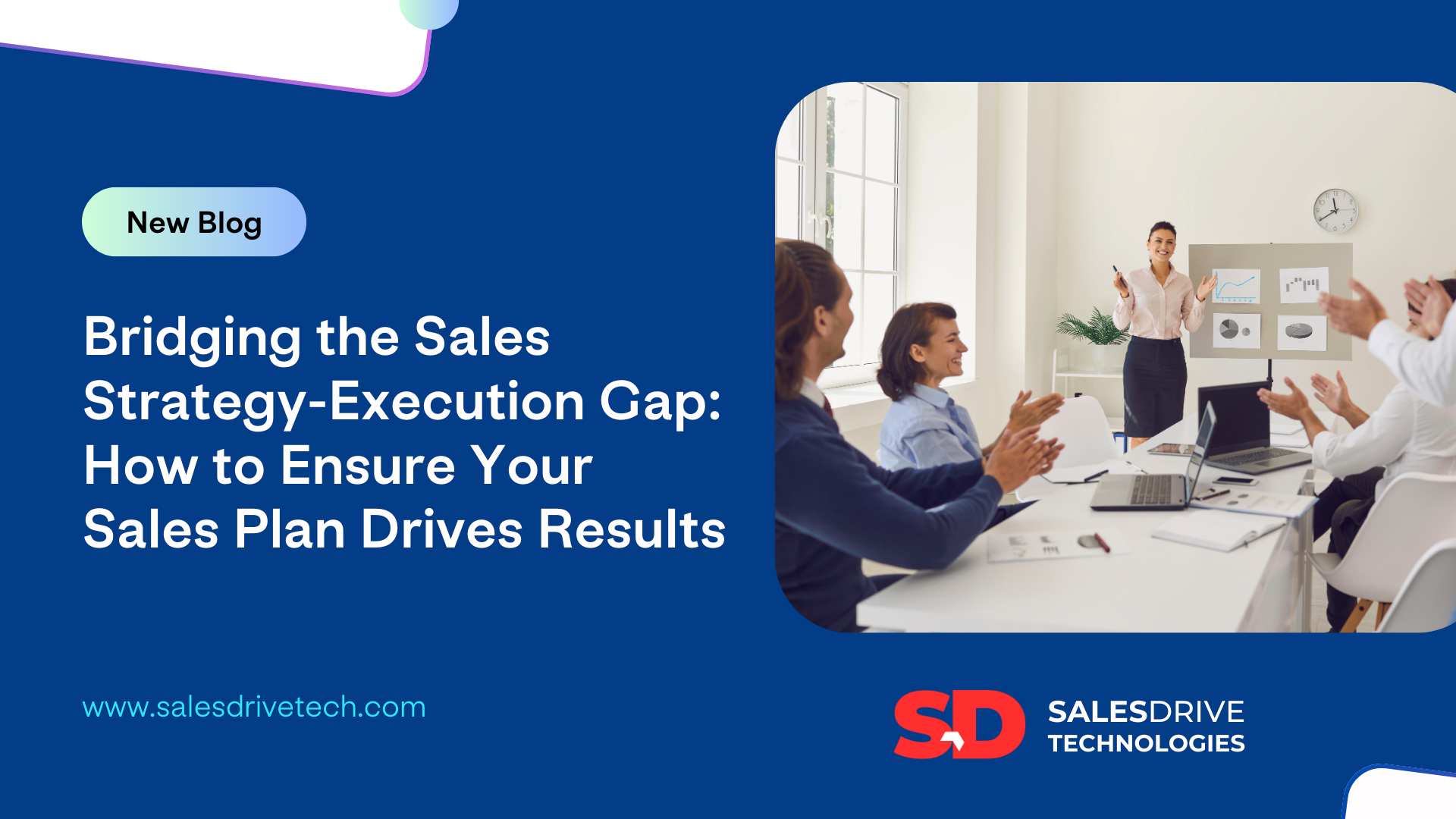Aligning sales strategy with execution is a common challenge that organizations face, even with advanced technology and data analytics. Companies may invest heavily in developing sales plans, setting ambitious targets, and utilizing sophisticated tools, only to see inconsistent results. The gap between strategy and execution often hinders revenue growth and reduces the productivity of sales teams.
This gap typically results from issues like rigid territory planning, unrealistic quota setting, and reliance on standalone CRM systems. Addressing these problems requires a shift to dynamic, integrated sales planning supported by real-time data. In this article, we explore the most common barriers to bridging the sales strategy-execution gap and provide actionable steps to close it effectively.
What is the Sales Strategy-Execution Gap?
The sales strategy-execution gap occurs when a well-crafted sales plan does not deliver the expected outcomes. It represents the difference between strategic goals for sales growth and the actual performance of sales teams. This gap can prevent organizations from meeting revenue targets and fully utilizing resources, leading to missed market opportunities and reduced competitive advantage.
Why Does It Happen?
Several factors contribute to the sales strategy-execution gap, including:
- Outdated Sales Processes: Many companies still rely solely on traditional CRM systems that lack advanced planning capabilities such as territory optimization and dynamic quota adjustments.
- Data Silos: Data is often scattered across systems like sales, finance, marketing, and operations, making it difficult to get a unified view for decision-making.
- Rigid Planning: Static sales plans fail to adapt to changing market conditions, customer needs, or team dynamics, resulting in misaligned strategies.
Common Pitfalls in Sales Strategy and Execution
- Ineffective Territory Planning: Rigid or outdated territory planning can create workload imbalances and missed opportunities. Without regular reassessment based on current market demand and performance metrics, organizations struggle to optimize coverage and effectively allocate resources.
- Unrealistic Quotas: Setting quotas without considering market trends or historical data can lead to unattainable targets that demotivate sales teams. When quotas are either too ambitious or too easy, they result in underperformance and disengagement, further widening the execution gap.
- Over-Reliance on CRM for Strategy: While essential for managing customer relationships, relying solely on CRMs for strategic planning is inadequate. Without integrating additional tools for analytics, forecasting, and performance management, organizations may overlook critical insights needed for effective sales planning.
Steps to Bridge the Gap and Drive Results
Step 1: Leverage Data Integration Across Functions
Integrating data from multiple systems (CRM, ERP, HRMS, and financial platforms) provides a holistic view of the sales landscape. This enables more informed decision-making by combining insights from sales, finance, operations, and HR.
To facilitate data integration, companies should adopt tools that allow real-time data sharing across functions. By breaking down data silos, these tools ensure consistency in planning and support informed decision-making across the organization.
Step 2: Implement Continuous Sales Planning and Monitoring
Static sales plans can quickly become outdated. To stay agile, companies should continuously reassess sales strategies, including territory plans, quotas, and sales targets. This allows organizations to respond rapidly to market shifts and competitive pressures.
Approaches to Continuous Planning:
- Regular Performance Reviews: Identify trends and risks through ongoing analysis of sales data.
- Quarterly Territory Adjustments: Adapt sales territories based on market conditions and team performance.
- Dynamic Quota Setting: Adjust quotas regularly to reflect current business conditions and forecasts.
Step 3: Use Advanced Scenario Modeling and Forecasting.
Scenario modeling enables organizations to visualize the potential impacts of various strategies, mitigating risks and optimizing resource allocation. As finance teams face fast-changing market conditions and uncertainties in long-range forecasts, relying on customized spreadsheets often leads to inefficiencies, lack of data transparency, and poor integration with operational plans. Oracle’s Scenario Modeling within Fusion Cloud EPM addresses these challenges by allowing users to rapidly create long-range forecast models that adapt to changing dynamics.
Key Features of Oracle’s Scenario Modeling
- Comprehensive Simulation:
Using Oracle Smart View and web interfaces based on historical data and trends, you can quickly create and evaluate multiple scenarios. - Dynamic Analytics:
Advanced analytics and machine learning provide real-time insights, enhancing forecast accuracy and enabling effective what-if analysis. - Collaborative Environment:
Cross-department collaboration among finance, sales, and marketing ensures all stakeholders have access to consistent data for informed decision-making. - Integration with Other Business Functions:
Seamless integration with Oracle’s cloud applications pulls data from CRM, ERP, and HRMS systems for holistic performance analysis while maintaining a streamlined general ledger. - Enhanced Profitability and Cost Management:
Robust data management capabilities facilitate easy mapping of financial and operational data, improving efficiency in profitability analysis.
Scenario Modeling Key Benefits
- Prebuilt Financial Intelligence for sophisticated what-if modeling.
- Complete Integration with financial and operational plans.
- Configurable Best Practices to simplify model-building.
- Increased Agility across ERP and operational processes.
- Improved Decision-Making through built-in intelligence and advanced analytics.
Step 4: Optimize CRM Usage with Connected Planning Solutions
While CRMs are essential for managing customer relationships, enhancing their capabilities with connected planning solutions is crucial for a data-driven sales strategy and execution. Oracle’s CRM seamlessly integrates with its cloud-based EPM suite, allowing for comprehensive territory management, resource allocation, and sales capacity planning. This integration ensures that data flows smoothly across various functions, aligning strategic initiatives with real-world execution.
Sales and Marketing Automation
Oracle CRM automated workflows, enabling marketing teams to focus on strategic tasks while allowing customer service agents to address complex inquiries. This efficiency strengthens customer relationships and improves satisfaction.
AI-Driven Insights
Oracle’s AI capabilities empower sales and marketing teams to prioritize leads, predict outcomes, and personalize customer interactions. These insights enable precise targeting and enhance account-based marketing efforts.
Collaborative Environment
As a single source of truth, Oracle CRM provides comprehensive customer data to all employees, fostering collaboration among sales, marketing, and service teams for better alignment and decision-making.
Enhanced ROI
Integrated CRM solutions drive profitability, with organizations reporting increases in proposal delivery rates, sales quota attainment, and lead conversion rates.
The journey towards aligning your sales strategy with execution is an ongoing process, and it’s essential to stay agile and responsive to market changes.
For those looking to optimize their sales planning and execution further, Salesdrive Technologies is here to help. As a leading provider of Oracle CX solutions, we specialize in Sales Performance Management (SPM) and Incentive Compensation Management (ICM) to empower your sales teams and drive sustainable growth. Discover how we can assist you in transforming your sales strategy into tangible results by visiting Salesdrive Technologies.




